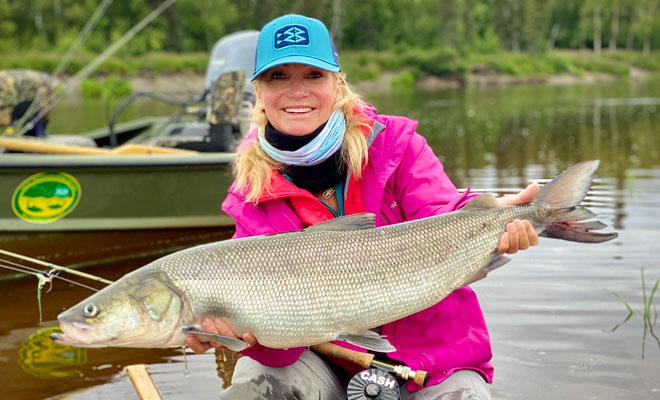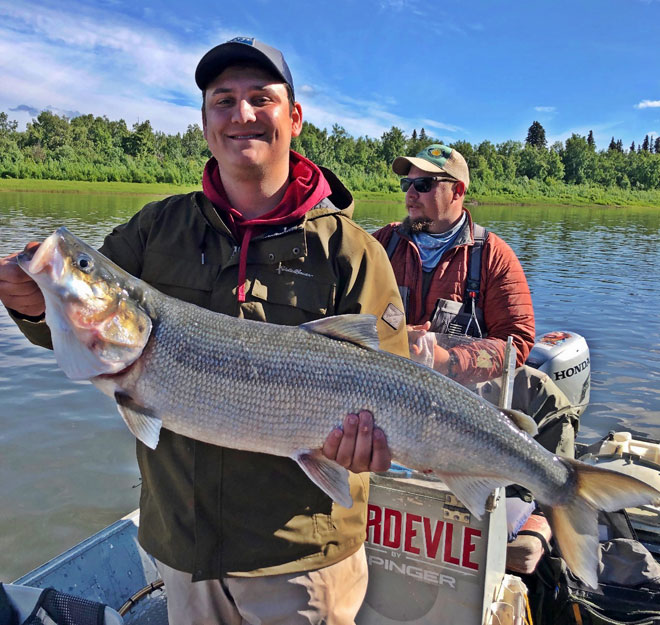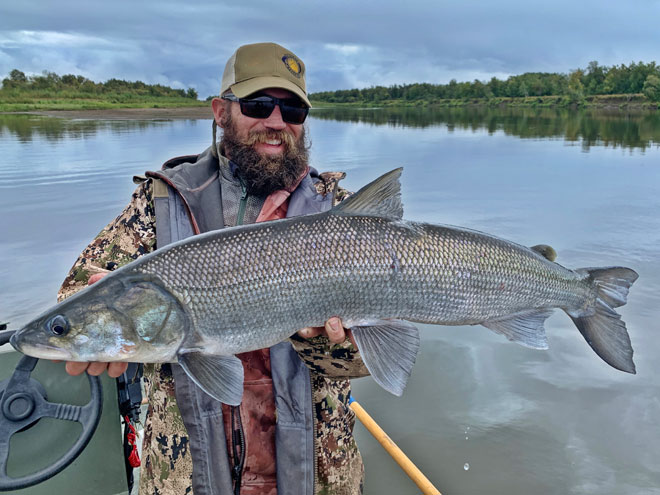Sheefish at Alaskan Adventures Blog
Story and photos provided by Dan Paull
 Sheefish are one of the most unique species we fish for at the Alaskan Adventures lodge. Only native to five drainages in the north, Alaskan Adventures sits on the banks of the southernmost river, the Holitna River. This is our homebase for fishing adventures in the area. With a main lodge, several cabins and meals prepared by a great chef, guests get to chase sheefish, pike, char, dollies and all five species of salmon from comfort.
Sheefish are one of the most unique species we fish for at the Alaskan Adventures lodge. Only native to five drainages in the north, Alaskan Adventures sits on the banks of the southernmost river, the Holitna River. This is our homebase for fishing adventures in the area. With a main lodge, several cabins and meals prepared by a great chef, guests get to chase sheefish, pike, char, dollies and all five species of salmon from comfort.
The sheefish is one of the most misunderstood gamefish species there is. For example, out of the five drainages in the north, the Kuskokwim drainage is the only river that they come to not only to spawn, but to feed as well. In all the rivers, some sheefish live in the salt and only return to spawn. Some just stay in brackish water, and some live their entire life in the river system. One thing is for sure, and that is no matter what, when you do find them, they are usually big. By that I mean on average we are talking 12- to 20 pounders in the waters around the lodge. Every year we see fish in the 30-pound range and hear about 40 pounders caught.
During our fishing season of June to September, sheefish move to different locations. The first part of the season we look at is late May to early June. Water is typically high with run off. During this time, it seems to us that we find some of the larger fish and schools of fish in more classic moving water runs. In areas you might look for trout on a classic trout stream. Our theory is that these are fish that are moving into the system and looking for that happy section of the river to call home for the summer season.
Our tactics for finding and fishing for sheefish during this part of the season is the first challenge of the year. Historically we know where to start looking however that changes constantly with the water level. When searching a run to see if any players are home, we have two possible go-to tactics this time of the year. First to cover lots of water when the water is high and really moving, we will troll a run with size 20 jet divers and flutter spoons. If ANY fish are in the area, they typically can’t resist a spoon and we can cover lots of water to find fish. Once fish are located, we go back and drift the run and throw swim baits. Four to six-inch paddletail swim baits on jig heads are deadly once you find where fish are holding. Also, once we find sheefish we also flyfish for them with weighted sink tips and 4” fry-pattern streamers. By far this is our favorite style of fishing for sheefish.
 As the season progresses more into summer and the water levels drop it seems that sheefish on our river system seem to move into what we refer to as summer home. Summer homes for sheefish seem to be more of larger deeper runs or pools where they can hold to some structure on the bottom and ambush schools of fry as they come over the top of them. Sheefish are not big fans of bright sunlight and really love the deep water; they constantly look to the top and use the light to see small fry against the back light. Once spotted they attack from the bottom upward and continue their thrust upward until bursting through the surface. It’s not uncommon to see an entire run as if it looks like the water is boiling with large sheefish.
As the season progresses more into summer and the water levels drop it seems that sheefish on our river system seem to move into what we refer to as summer home. Summer homes for sheefish seem to be more of larger deeper runs or pools where they can hold to some structure on the bottom and ambush schools of fry as they come over the top of them. Sheefish are not big fans of bright sunlight and really love the deep water; they constantly look to the top and use the light to see small fry against the back light. Once spotted they attack from the bottom upward and continue their thrust upward until bursting through the surface. It’s not uncommon to see an entire run as if it looks like the water is boiling with large sheefish.
During summer months we typically fish sheefish with either swimbaits or the fly. Mostly depending on clients and how they wish to catch fish determines how we target sheefish. For conventional tackle, spinners, spoons and swimbaits all work great for sheefish. For fly gear as long as the fly has lots of movement and looks like a smolt or even baby lamprey they will attack it with a gusto. We still will fish sink tips with our flies and sheefish will attack in an upward aggressive strike, so the grab is usually quite visual.
 As summer progresses sheefish start to move through the river system and into their spawning mode. Where we seem to find them is more of a hunt. They don’t typically “hold” in an area for a long period of time. It seems like once a nice school has gathered, they then stick together and shoot upriver with reproduction on their mind. A big difference between sheefish and most spawning anadromous fish is that they still feed during their spawning period. Salmon clearly don’t. We find them where we find them. What I mean is one day an area that looks prime will be completely void and then the next day that area will be full of fish. Sometimes areas we would never think would have sheefish in the fall end up having a few hawgs. It’s a hit and miss game in the fall, however we know where exactly to look. With a river like the Holitna being so large, knowing where to look can be a daunting task.
As summer progresses sheefish start to move through the river system and into their spawning mode. Where we seem to find them is more of a hunt. They don’t typically “hold” in an area for a long period of time. It seems like once a nice school has gathered, they then stick together and shoot upriver with reproduction on their mind. A big difference between sheefish and most spawning anadromous fish is that they still feed during their spawning period. Salmon clearly don’t. We find them where we find them. What I mean is one day an area that looks prime will be completely void and then the next day that area will be full of fish. Sometimes areas we would never think would have sheefish in the fall end up having a few hawgs. It’s a hit and miss game in the fall, however we know where exactly to look. With a river like the Holitna being so large, knowing where to look can be a daunting task.
Usually in the fall we are more focused on the silver salmon run than actually fishing for sheefish. We usually catch sheefish on pink spinners, spoons and pink jigs as bycatch. We can still target them with the traditional gear of spoons, spinners and swimbaits. When flyfishing for sheefish we would still fish with the same flies as we do all summer. Four-inch smolt patterns and baby lamprey imitations all with LOTS of movement are absolutely deadly all-year round.
September is the end of our season on the Holitna River and we look forward to next year’s fishing season. Sheefish however are in the river system year-round. We have heard rumors of fish being caught through the ice. We decide to head south in search of warmer waters. To find out what they fight like, and even what they taste like, drop us a line and we would gladly get you on fish. Who knows maybe you will set the next IGFA Record?
Dan Paull, Alaskan Adventures
(303) 881-0200
